fuel pressure FIAT DUCATO 244 2005 3.G Owners Manual
[x] Cancel search | Manufacturer: FIAT, Model Year: 2005, Model line: DUCATO 244, Model: FIAT DUCATO 244 2005 3.GPages: 258, PDF Size: 4.05 MB
Page 105 of 258

104GETTING TO KNOW YOUR VEHICLE
IMPORTANTThe airtight seal of
the cap may lead to a slight increase of
pressure in the tank. A hissing sound
when the cap is removed is therefore
quite normal.
After refuelling, screw the cap until
hearing one or more clicks, turn the
key and then remove it.. close the lid.
IMPORTANTMoreover, before
starting the engine, for the sake of
safety, check whether the refuelling
gun is properly hung onto the fuel
pump.If required, replace the
fuel cap with another gen-
uine cap to avoid affecting
the efficiency of the fuel vapour
recovery system.
fig. 153
F0D0140m
PROTECTING THE
ENVIRONMENT
Protection of the environment has
been the guiding principle in the design
of the Fiat Ducato right from the start.
The result is the use of materials and
creation of devices that can reduce or
considerably curtail harmful influences
on the environment.
The devices for curtailing petrol en-
gine emissions are:
– a three-way catalytic converter;
– a lambda sensor;
– a fuel evaporation system.
The devices for curtailing diesel en-
gine emissions are:
– an oxidising catalytic converter;
– an exhaust gas recirculation system
(E.G.R.) (for certain versions).
Consequently, the Fiat Ducato is
ready to travel well ahead of the most
stringent international pollution control
standards.
Keep naked flames or light-
ed cigarettes away from
the fuel filler hole as there is a dan-
ger of fire. Do not bend too close to
the hole either so as not to breathe
in harmful vapours.
WARNING
Page 125 of 258
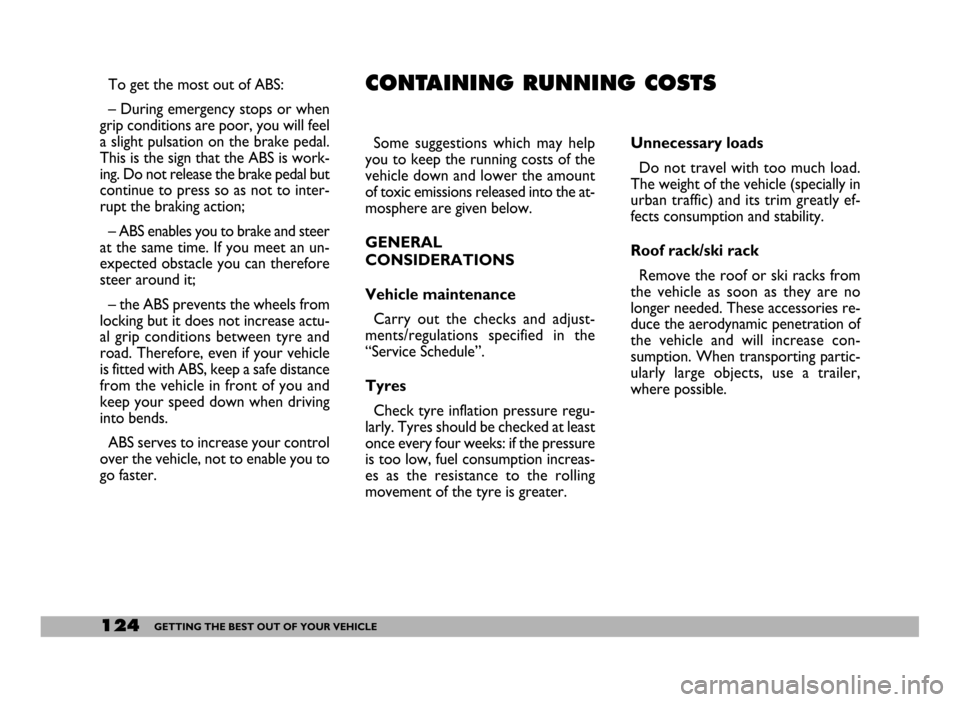
124GETTING THE BEST OUT OF YOUR VEHICLE
To get the most out of ABS:
– During emergency stops or when
grip conditions are poor, you will feel
a slight pulsation on the brake pedal.
This is the sign that the ABS is work-
ing. Do not release the brake pedal but
continue to press so as not to inter-
rupt the braking action;
– ABS enables you to brake and steer
at the same time. If you meet an un-
expected obstacle you can therefore
steer around it;
– the ABS prevents the wheels from
locking but it does not increase actu-
al grip conditions between tyre and
road. Therefore, even if your vehicle
is fitted with ABS, keep a safe distance
from the vehicle in front of you and
keep your speed down when driving
into bends.
ABS serves to increase your control
over the vehicle, not to enable you to
go faster.Some suggestions which may help
you to keep the running costs of the
vehicle down and lower the amount
of toxic emissions released into the at-
mosphere are given below.
GENERAL
CONSIDERATIONS
Vehicle maintenance
Carry out the checks and adjust-
ments/regulations specified in the
“Service Schedule”.
Tyres
Check tyre inflation pressure regu-
larly. Tyres should be checked at least
once every four weeks: if the pressure
is too low, fuel consumption increas-
es as the resistance to the rolling
movement of the tyre is greater.Unnecessary loads
Do not travel with too much load.
The weight of the vehicle (specially in
urban traffic) and its trim greatly ef-
fects consumption and stability.
Roof rack/ski rack
Remove the roof or ski racks from
the vehicle as soon as they are no
longer needed. These accessories re-
duce the aerodynamic penetration of
the vehicle and will increase con-
sumption. When transporting partic-
ularly large objects, use a trailer,
where possible.CONTAINING RUNNING COSTS
Page 164 of 258
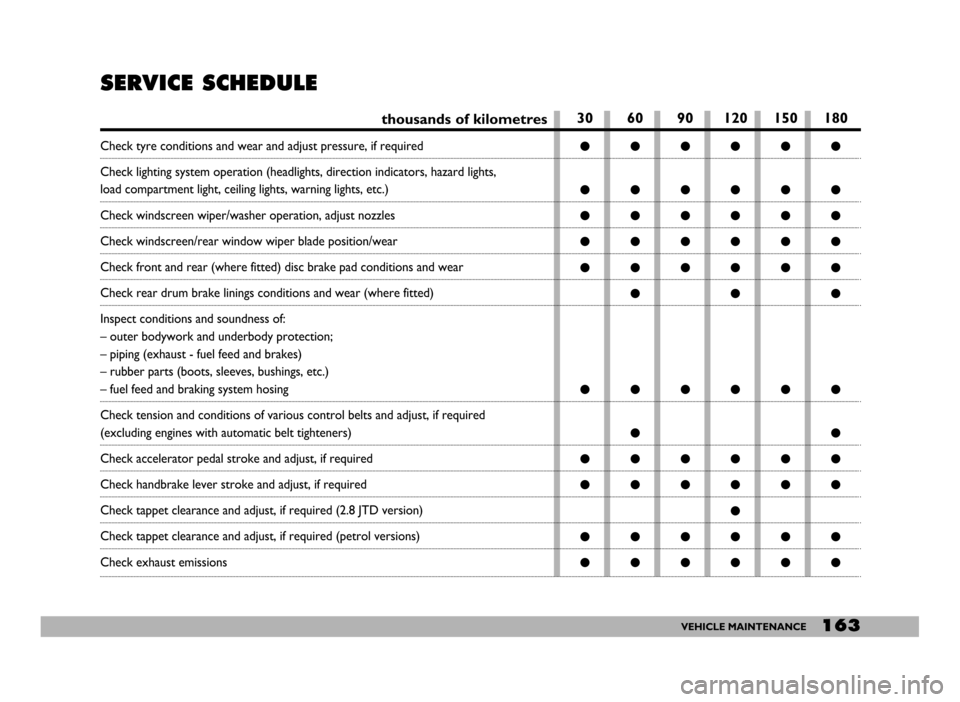
163VEHICLE MAINTENANCE
SERVICE SCHEDULE
thousands of kilometres
Check tyre conditions and wear and adjust pressure, if required
Check lighting system operation (headlights, direction indicators, hazard lights,
load compartment light, ceiling lights, warning lights, etc.)
Check windscreen wiper/washer operation, adjust nozzles
Check windscreen/rear window wiper blade position/wear
Check front and rear (where fitted) disc brake pad conditions and wear
Check rear drum brake linings conditions and wear (where fitted)
Inspect conditions and soundness of:
– outer bodywork and underbody protection;
– piping (exhaust - fuel feed and brakes)
– rubber parts (boots, sleeves, bushings, etc.)
– fuel feed and braking system hosing
Check tension and conditions of various control belts and adjust, if required
(excluding engines with automatic belt tighteners)
Check accelerator pedal stroke and adjust, if required
Check handbrake lever stroke and adjust, if required
Check tappet clearance and adjust, if required (2.8 JTD version)
Check tappet clearance and adjust, if required (petrol versions)
Check exhaust emissions
30 60 90 120 150 180
●●●●●●
●●●●●●
●●●●●●
●●●●●●
●●●●●●
●●●
●●●●●●
●●
●●●●●●
●●●●●●
●
●●●●●●
●●●●●●
Page 166 of 258
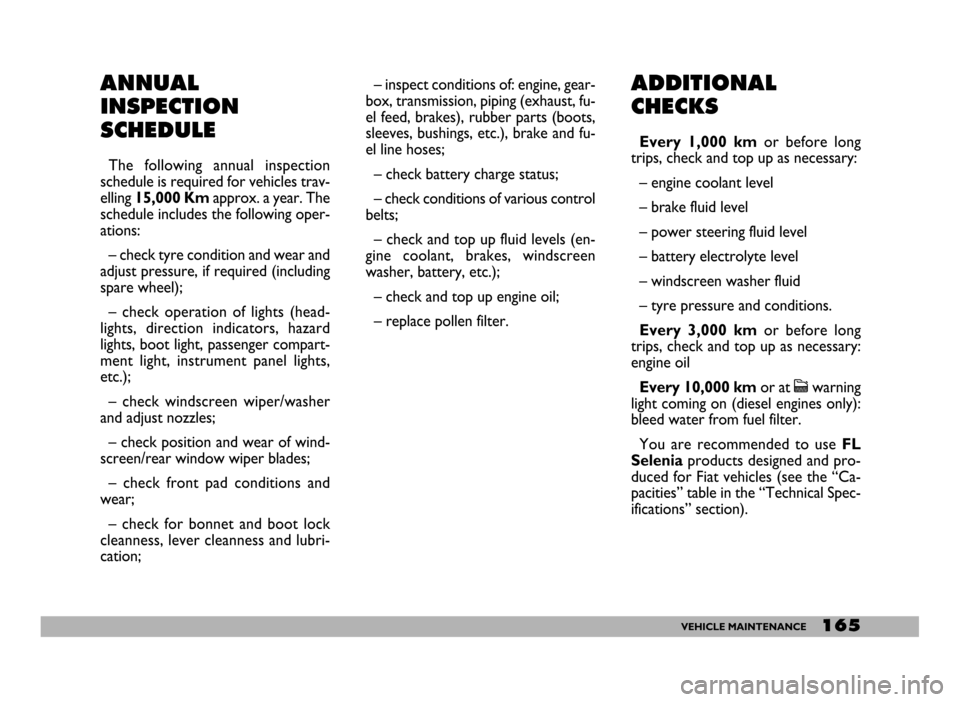
165VEHICLE MAINTENANCE
ANNUAL
INSPECTION
SCHEDULE
The following annual inspection
schedule is required for vehicles trav-
elling 15,000 Kmapprox. a year. The
schedule includes the following oper-
ations:
– check tyre condition and wear and
adjust pressure, if required (including
spare wheel);
– check operation of lights (head-
lights, direction indicators, hazard
lights, boot light, passenger compart-
ment light, instrument panel lights,
etc.);
– check windscreen wiper/washer
and adjust nozzles;
– check position and wear of wind-
screen/rear window wiper blades;
– check front pad conditions and
wear;
– check for bonnet and boot lock
cleanness, lever cleanness and lubri-
cation;– inspect conditions of: engine, gear-
box, transmission, piping (exhaust, fu-
el feed, brakes), rubber parts (boots,
sleeves, bushings, etc.), brake and fu-
el line hoses;
– check battery charge status;
– check conditions of various control
belts;
– check and top up fluid levels (en-
gine coolant, brakes, windscreen
washer, battery, etc.);
– check and top up engine oil;
– replace pollen filter.
ADDITIONAL
CHECKS
Every 1,000 km or before long
trips, check and top up as necessary:
– engine coolant level
– brake fluid level
– power steering fluid level
– battery electrolyte level
– windscreen washer fluid
– tyre pressure and conditions.
Every 3,000 km or before long
trips, check and top up as necessary:
engine oil
Every 10,000 kmor at cwarning
light coming on (diesel engines only):
bleed water from fuel filter.
You are recommended to use FL
Seleniaproducts designed and pro-
duced for Fiat vehicles (see the “Ca-
pacities” table in the “Technical Spec-
ifications” section).
Page 230 of 258
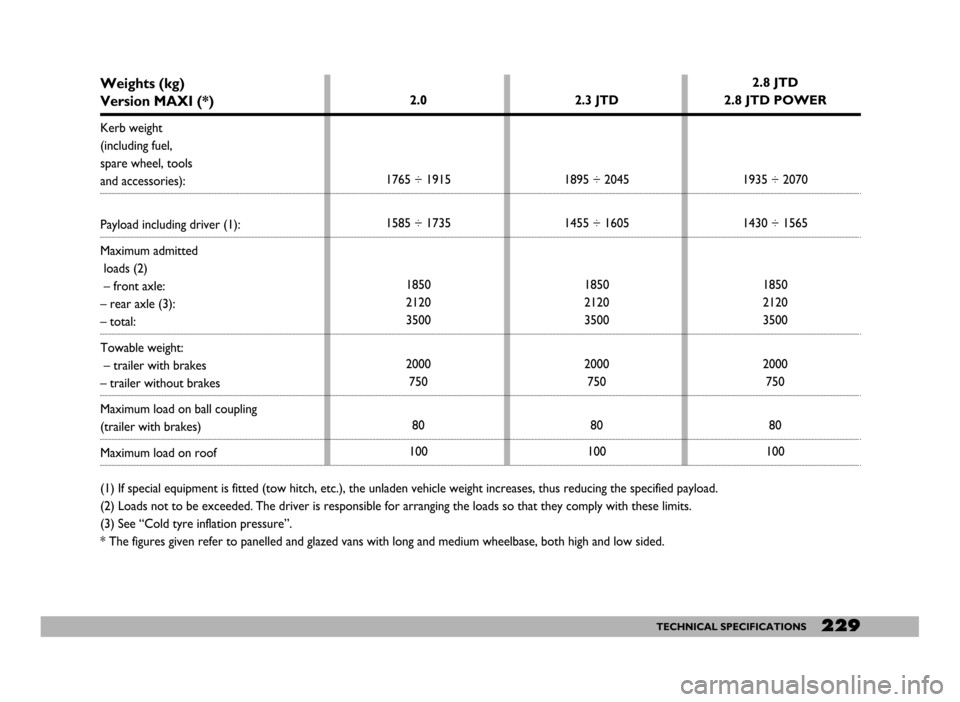
229TECHNICAL SPECIFICATIONS
Weights (kg)
Version MAXI (*)
Kerb weight
(including fuel,
spare wheel, tools
and accessories):
Payload including driver (1):
Maximum admitted
loads (2)
– front axle:
– rear axle (3):
– total:
Towable weight:
– trailer with brakes
– trailer without brakes
Maximum load on ball coupling
(trailer with brakes)
Maximum load on roof
(1) If special equipment is fitted (tow hitch, etc.), the unladen vehicle weight increases, thus reducing the specified payload.
(2) Loads not to be exceeded. The driver is responsible for arranging the loads so that they comply with these limits.
(3) See “Cold tyre inflation pressure”.
* The figures given refer to panelled and glazed vans with long and medium wheelbase, both high and low sided.2.0
1765 ÷ 1915
1585 ÷ 1735
1850
2120
3500
2000
750
80
1002.3 JTD
1895 ÷ 2045
1455 ÷ 1605
1850
2120
3500
2000
750
80
100
2.8 JTD
2.8 JTD POWER
1935 ÷ 2070
1430 ÷ 1565
1850
2120
3500
2000
750
80
100
Page 238 of 258
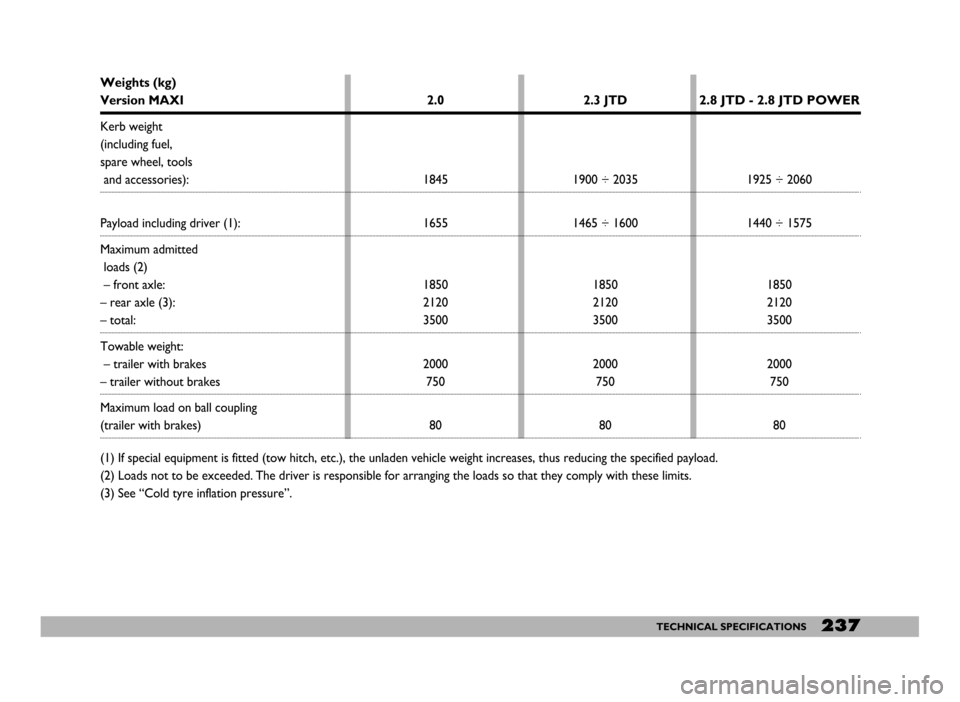
237TECHNICAL SPECIFICATIONS
Weights (kg)
Version MAXI
Kerb weight
(including fuel,
spare wheel, tools
and accessories):
Payload including driver (1):
Maximum admitted
loads (2)
– front axle:
– rear axle (3):
– total:
Towable weight:
– trailer with brakes
– trailer without brakes
Maximum load on ball coupling
(trailer with brakes)
(1) If special equipment is fitted (tow hitch, etc.), the unladen vehicle weight increases, thus reducing the specified payload.
(2) Loads not to be exceeded. The driver is responsible for arranging the loads so that they comply with these limits.
(3) See “Cold tyre inflation pressure”.2.0
1845
1655
1850
2120
3500
2000
750
802.3 JTD
1900 ÷ 2035
1465 ÷ 1600
1850
2120
3500
2000
750
80
2.8 JTD - 2.8 JTD POWER
1925 ÷ 2060
1440 ÷ 1575
1850
2120
3500
2000
750
80
Page 239 of 258
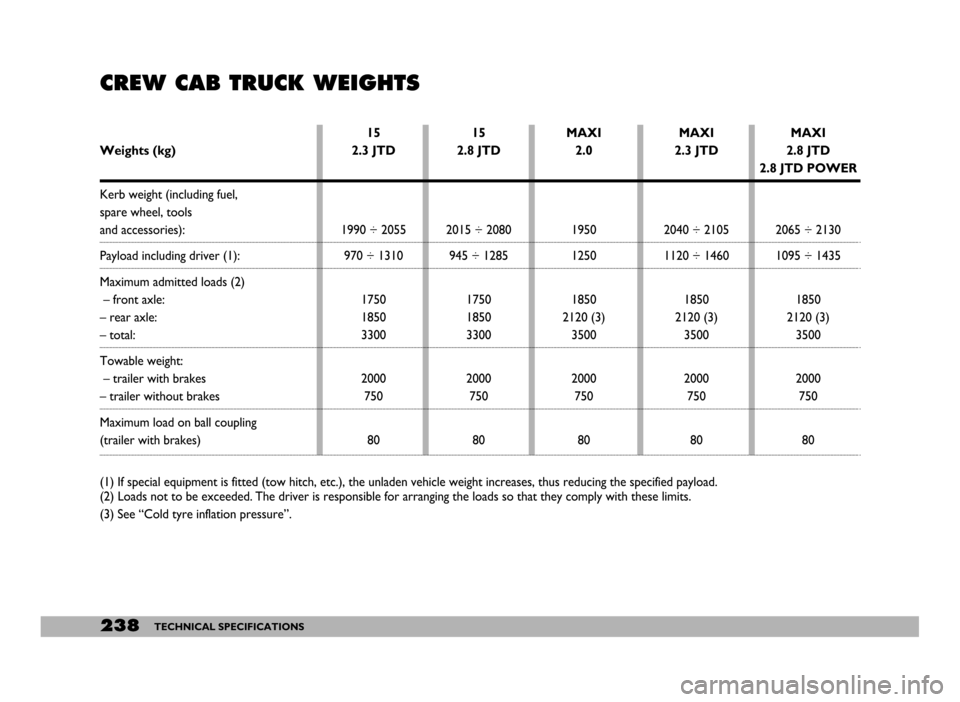
238TECHNICAL SPECIFICATIONS
CREW CAB TRUCK WEIGHTS
Weights (kg)
Kerb weight (including fuel,
spare wheel, tools
and accessories):
Payload including driver (1):
Maximum admitted loads (2)
– front axle:
– rear axle:
– total:
Towable weight:
– trailer with brakes
– trailer without brakes
Maximum load on ball coupling
(trailer with brakes)
(1) If special equipment is fitted (tow hitch, etc.), the unladen vehicle weight increases, thus reducing the specified payload.
(2) Loads not to be exceeded. The driver is responsible for arranging the loads so that they comply with these limits.
(3) See “Cold tyre inflation pressure”.15
2.3 JTD
1990 ÷ 2055
970 ÷ 1310
1750
1850
3300
2000
750
8015
2.8 JTD
2015 ÷ 2080
945 ÷ 1285
1750
1850
3300
2000
750
80MAXI
2.0
1950
1250
1850
2120 (3)
3500
2000
750
80MAXI
2.3 JTD
2040 ÷ 2105
1120 ÷ 1460
1850
2120 (3)
3500
2000
750
80MAXI
2.8 JTD
2.8 JTD POWER
2065 ÷ 2130
1095 ÷ 1435
1850
2120 (3)
3500
2000
750
80
Page 244 of 258
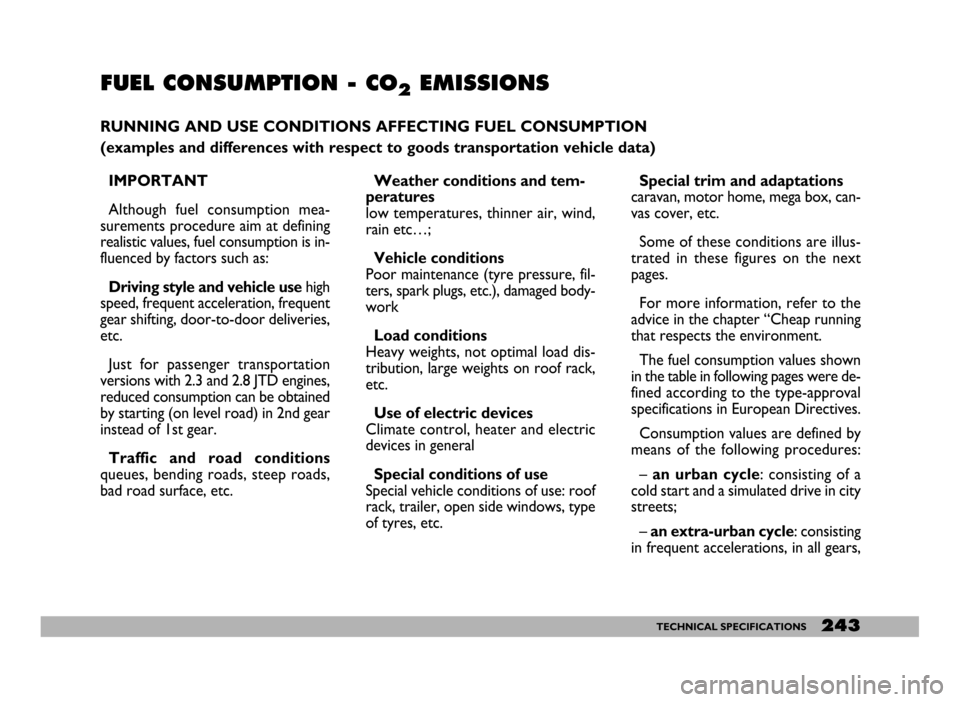
243TECHNICAL SPECIFICATIONS
FUEL CONSUMPTION - CO2EMISSIONS
RUNNING AND USE CONDITIONS AFFECTING FUEL CONSUMPTION
(examples and differences with respect to goods transportation vehicle data)
IMPORTANT
Although fuel consumption mea-
surements procedure aim at defining
realistic values, fuel consumption is in-
fluenced by factors such as:
Driving style and vehicle usehigh
speed, frequent acceleration, frequent
gear shifting, door-to-door deliveries,
etc.
Just for passenger transportation
versions with 2.3 and 2.8 JTD engines,
reduced consumption can be obtained
by starting (on level road) in 2nd gear
instead of 1st gear.
Traffic and road conditions
queues, bending roads, steep roads,
bad road surface, etc.Weather conditions and tem-
peratures
low temperatures, thinner air, wind,
rain etc…;
Vehicle conditions
Poor maintenance (tyre pressure, fil-
ters, spark plugs, etc.), damaged body-
work
Load conditions
Heavy weights, not optimal load dis-
tribution, large weights on roof rack,
etc.
Use of electric devices
Climate control, heater and electric
devices in general
Special conditions of use
Special vehicle conditions of use: roof
rack, trailer, open side windows, type
of tyres, etc.Special trim and adaptations
caravan, motor home, mega box, can-
vas cover, etc.
Some of these conditions are illus-
trated in these figures on the next
pages.
For more information, refer to the
advice in the chapter “Cheap running
that respects the environment.
The fuel consumption values shown
in the table in following pages were de-
fined according to the type-approval
specifications in European Directives.
Consumption values are defined by
means of the following procedures:
– an urban cycle: consisting of a
cold start and a simulated drive in city
streets;
– an extra-urban cycle: consisting
in frequent accelerations, in all gears,
Page 257 of 258
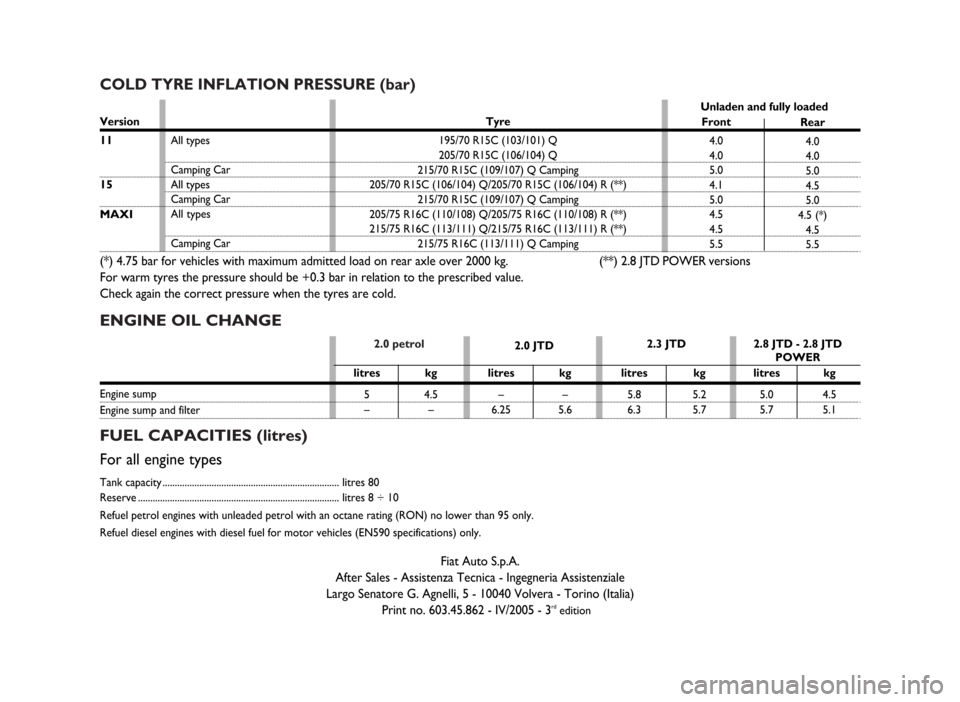
2.0 petrol
COLD TYRE INFLATION PRESSURE (bar)
ENGINE OIL CHANGE
FUEL CAPACITIES (litres)
For all engine types
Tank capacity ........................................................................ litres 80
Reserve .................................................................................. litres 8 ÷ 10
Refuel petrol engines with unleaded petrol with an octane rating (RON) no lower than 95 only.
Refuel diesel engines with diesel fuel for motor vehicles (EN590 specifications) only.
Version
11
15
MAXI
(*) 4.75 bar for vehicles with maximum admitted load on rear axle over 2000 kg. (**) 2.8 JTD POWER versions
For warm tyres the pressure should be +0.3 bar in relation to the prescribed value.
Check again the correct pressure when the tyres are cold.
Unladen and fully loaded
Rear
4.0
4.0
5.0
4.5
5.0
4.5 (*)
4.5
5.5 Front
4.0
4.0
5.0
4.1
5.0
4.5
4.5
5.5 All types
Camping Car
All types
Camping Car
All types
Camping CarTyre
195/70 R15C (103/101) Q
205/70 R15C (106/104) Q
215/70 R15C (109/107) Q Camping
205/70 R15C (106/104) Q/205/70 R15C (106/104) R (**)
215/70 R15C (109/107) Q Camping
205/75 R16C (110/108) Q/205/75 R16C (110/108) R (**)
215/75 R16C (113/111) Q/215/75 R16C (113/111) R (**)
215/75 R16C (113/111) Q Camping
2.8 JTD - 2.8 JTD
POWER
litres
5
–kg
4.5
–kg
–
5.6litres
5.0
5.7 kg
5.2
5.7kg
4.5
5.1 2.3 JTD
Fiat Auto S.p.A.
After Sales - Assistenza Tecnica - Ingegneria Assistenziale
Largo Senatore G. Agnelli, 5 - 10040 Volvera - Torino (Italia)
Print no. 603.45.862 - IV/2005 - 3
rdedition 2.0 JTD
litres
–
6.25litres
5.8
6.3
Engine sump
Engine sump and filter